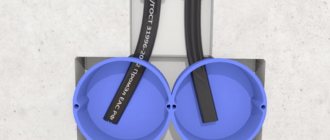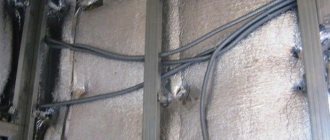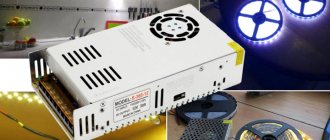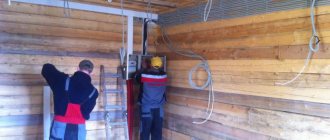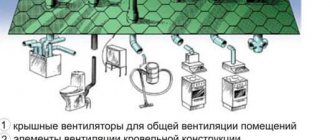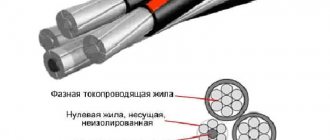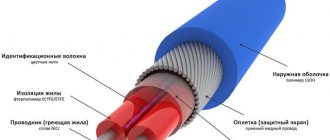There are usually a lot of household appliances used in modern houses and apartments. Therefore, the standard 1-2 sockets per room are not enough for property owners these days. Accordingly, in most cases, owners of apartments and houses install additional connection sockets in their homes. Of course, such a procedure should be carried out according to all the rules, observing certain standards. For example, during installation you should, among other things, maintain certain distances between socket boxes.
Why group
Of course, you can place sockets in the house in different places. However, too many of them over the entire wall area will most likely greatly spoil the appearance of the room. Therefore, in modern apartments, sockets in most cases are simply placed several times in one place. This allows you to maintain the attractive appearance of the walls and make the connection sockets less noticeable. Also, this installation method makes the subsequent operation of sockets more convenient. After all, most often different kinds of household appliances are located in apartments not far from each other.
Grouping rules
We’ll talk about what distance between socket outlets in a group should be chosen below. First, let's figure out what technologies can be used to install connection sockets in the block.
In a house, you can, of course, install several separate sockets in the same place, simply by placing the sockets close to each other at the same level from the floor. However, electricians rarely use this method of installation. When using this technology, it will most likely not be possible to mount the connection sockets absolutely evenly and neatly.
Therefore, in most cases, before installation, electricians group socket boxes into a single structure. Subsequently, such a block is simply mounted into the wall in one step. In a similar way, installers achieve a neat appearance of nests installed in the house. Sockets are usually collected in groups of 2-5 pieces. For industrial premises, blocks with a larger number of connection sockets can be used.
Installation Rules
The distance between the sockets in the block should be such that using the connection sockets in the future would be as convenient and safe as possible. But such groups themselves in the house, of course, need to be placed in accordance with certain requirements. For example, regulations do not allow installation of connection sockets closer than 50 cm to sinks and sinks. Also, such elements are not allowed to be installed at a distance of less than 60 cm from gas pipes.
Sockets are usually installed in the house at a height of 30-40 cm from the floor. Previously, such elements of a household network were most often installed higher - at a height of up to 90 cm. However, a whole group of sockets, as opposed to 1-2, mounted at such a height, will most likely spoil the appearance of the wall. Connection sockets installed closer to the floor are not so noticeable. In addition, it is more convenient to use sockets with this installation in the future. The comfort of the apartment owners will not be hampered by wires stretched everywhere.
From the slopes of windows and doors, such groups should be installed in such a way that the distance from them to the first socket is not less than 10-12 cm. It is better if it is the same in all rooms.
Groups can gather both from power outlets and from regular ones. According to the regulations, it is impossible to combine these types in one frame. Otherwise, powerful cables will interfere with the operation of regular outlets. It is also recommended to place power groups from ordinary sockets on one wall at a distance no further than the diameter of one socket box. This is also necessary to ensure that power cables do not subsequently interfere with the operation of normal connection sockets.
Rules for installing a socket box
The operating procedure is as follows:
- Using a d-6mm drill (or the same as on the crown), drill the center of the niches of future socket boxes (71mm between the “holes” if we are talking about a block)
Drilling depth - 5cm.
- Using the selected crown, drill out 5-10mm of concrete, after which the centering drill is pulled out from the crown
If you leave it, then when the hammer shakes during operation, the drill may become wedged and break off. In addition, when diamond drilling without impact, the drill will only smooth the concrete and interfere with the work.
- finish drilling the concrete with a crown to the required depth (about 5 cm)
The depth can be set in advance by placing the box on the bit and marking the required drilling distance with a marker.
When drilling, you need to rock the hammer slightly from side to side. This is necessary so that the sludge comes out and the crown does not jam. In this case, you need to adapt, since strong swaying also leads to a wedge.
This action greatly influences both the speed of operation and the increase in the service life of the product.
What is a socket box
Connection sockets for electrical appliances are mounted into the wall in a special hollow housing. Such an element is called a socket box. The dimensions of this type of product are standard in our country. Their diameter is almost always 68 mm. The distance between the socket boxes is 68 mm, therefore, will also be standard.
Such cases are usually made of plastic. On the sides of each socket box there are special mounting ears. Through such elements, these buildings are assembled into groups. The socket boxes can also be attached to each other using the tongue/groove system.
There are two main types of such housings on sale today: those designed for installation in brick or concrete walls and those used on drywall. The latter type of socket boxes have special elements that allow them to be tightly secured to the gypsum board. Also on sale these days you can sometimes find housings for recessed sockets. They differ from ordinary socket boxes only in their longer length.
What distance should be between socket boxes?
How to properly mount connection socket housings in a group? These elements are connected in such a way that exactly 71 mm of free space remains between the centers of their axes. The enclosures are installed into the wall in special mounting sockets, previously made using a hammer drill and a special crown. The distance between standard socket boxes should be 71 mm, and this is how the recesses in the wall for such elements are knocked out.
The diameter of nests built in concrete, brick or, for example, drywall can be different. Usually it is 68 mm plus 1-1.5 mm. In this case, gypsum mortar is subsequently hammered into the gap between the socket box and the walls of the nest. After hardening, the latter firmly holds the socket body in the wall. Experienced electricians do not recommend leaving a gap that is too large for the solution. In this case, the sockets may subsequently fall out of the wall along with the frozen mixture.
What difficulties may arise during installation?
As you can see, the technology for installing groups of sockets is extremely simple. However, in practice, when installing such elements, craftsmen usually, unfortunately, encounter certain difficulties.
The distance between two socket boxes in a group is usually only 71 mm. This is certainly not too much. However, the close arrangement of the elements still practically does not impart rigidity to the blocks. Groups assembled from cases usually bend in different directions.
Because of this, when installed in sockets with a solution, the socket boxes begin to shift relative to each other. In addition, they can be very difficult to install at the same level with the plane of the wall. To ensure that a group of sockets subsequently looks neat and attractive, experienced electricians advise beginners to use a special template during installation. You can make such a device with your own hands in just a few minutes.
Installation in a wooden wall
The installation box for sockets, which is installed in a wooden house, is made of thin metal, therefore, when installing hidden wiring in wood, it is necessary to use a crown slightly smaller in diameter than the outer circumference of the part.
When drilling, wood may slightly burn out, which will make installing a box for switches and sockets impossible, due to the discrepancy between the diameters of the hole and the socket box.
How to make a template
The distance between the socket boxes for the group should therefore be 71 mm. To mount the block as accurately as possible, you need to purchase 1 aluminum corner 40x40 mm. To make a template, you will need a piece of such material approximately 60 cm long (depending on the number of socket boxes in the group). On one of the shelves of the corner segment, you need to draw a straight line exactly in the middle.
Next, along this line, holes are drilled for the fasteners of each socket box. A 3 mm drill should be used for this. At the next stage, all socket boxes should be connected into a group and attached to the corner on the reverse side with self-tapping screws. Such a template will be longer than a row of nests knocked out in concrete or brick. Therefore, with its help it will be possible to insert socket boxes in exact accordance with the plane of the wall.
How to drill sockets
Seats for socket boxes, as already mentioned, are usually knocked out using a hammer drill and a special attachment for it - a crown. First, of course, you need to make markings on the wall by drawing a circle for each socket. Next, the crown is placed against the wall and, first at low speeds, and then at high speeds, the sockets are knocked out.
If there is no special attachment for a hammer drill in the house, sockets for sockets can be made in another way. To do this, according to the markings, first drill a series of holes as close to each other as possible. Then the nest itself is knocked out with a chisel.
Installation in high-strength concrete with reinforcement
If the concrete turns out to be highly durable, you start drilling and realize that this will take a long time, you can make your work much easier.
To do this, make several holes along the circle you started with an 8mm drill. You should end up with something similar to a revolver drum.
After this, continue with diamond or impact drilling. From there it should go like clockwork.
If you hit a large piece of reinforcement and you don’t want to ruin the new crown, then you can get out of the situation in two ways:
- switch the hammer drill to the chipper mode and knock it out with a chisel
True, this can greatly contribute to the appearance of new cracks in the plaster.
- remove a good crown and put in an old used one, then, without sparing it, chew through a metal rod (do not throw away the old ones, they may still be useful)
Knock out the concrete from the niche (using a chisel and hammer or a hammer drill), while providing a bevel for inserting the cable into the socket box.
Use a vacuum cleaner to remove all debris and dust.
How to mark up correctly
This operation can be performed with an ordinary simple pencil. Under each circle on the wall, you first need to draw approximate horizontal and vertical lines. Next, using a compass, you should apply circles on the wall with a slightly larger diameter than the diameter of the socket boxes. Experienced craftsmen advise drawing approximate lines in such a way that they protrude beyond the circle. In this case, drilling the wall exactly according to the markings will be easier in the future.
Sometimes craftsmen, when installing a group on a template, do not even drill a hole for each socket box. In this case, one common long nest is simply made in the wall. After installing the sockets, it is simply sealed with gypsum or cement putty.
What are socket outlets for?
Since the boxes are installed inside the wall in the hole for the socket box. Therefore, many do not know what to do with these products, and sometimes are not even aware of their existence. However, this is the best solution for hidden electrical wiring, without which the installation of modern sockets and switches is impossible. Thanks to its simple design, it is quite possible to install the mounting box on your own, without the involvement of qualified specialists.
The configuration of the socket box looks like a plastic or metal cup installed in a hole pre-drilled in the wall. Inside it is a socket or switch mechanism. Decorative frames are fixed on top, which make the entire structure invisible. To drill holes, crowns for socket boxes are used.
Owners often have questions about the possibility of somehow doing installation without such boxes and installing switching device mechanisms directly into the wall. To solve this problem once and for all, it is necessary to consider in more detail the main functions of the socket box and why it is needed:
- They guarantee reliable fixation of the mechanisms inside the box. This is especially true for a group of sockets from which the plugs of household devices are regularly pulled out. Fastening is carried out using the spacer legs of the mechanisms or using special screws located in the socket itself.
- Dielectric function. Plastic ensures reliable insulation of the socket contacts with the wall material. Concrete contains metal structures, contact with which can cause current leaks or short circuits.
- Fireproof function. Boxes made from metal or non-flammable plastic protect against fires if the right choice is made.
- Often, socket boxes act as distribution boxes if they are not provided for in the wiring diagram.
And finally, it should be noted that savings on socket boxes are very doubtful, since these products are inexpensive.
How to install enclosures
Thus, the distance between socket boxes mounted into the wall should be 71 mm. After the nests are punched, grooves are made in the wall for the leash. They are usually pierced using a grinder. At the next stage, the cables themselves are laid in the grooves and brought out into the sockets for the socket boxes. At the next stage, the procedure should be as follows:
- The socket boxes are installed into the sockets using a template and leveled;
- the template is fixed on the wall;
- the nests are covered with gypsum or cement putty.
After hardening, you just need to unscrew the template from the wall and remove it from the sockets. Next, you can begin installing the sockets themselves.
Preparing the solution and installing it in a niche
The next stage is the installation of the socket boxes themselves in the prepared niches. You can install socket boxes on alabaster, putty or plaster.
The hardening time of the plaster is approximately four to five minutes. Of course, finishing the installation job in 5 minutes is not a problem. The main headache is the hardening of the prepared solution in a diluted container and the inability to use it for other work.
Therefore, to prevent the plaster from hardening too quickly, you can mix plaster (Rotband) into it. You will gain an extra 10-20 minutes. Add 2 parts putty to 3 parts plaster.
The plaster just holds much weaker. When hardening, the cement mortar shrinks, but the gypsum, on the contrary, expands slightly and securely clamps the socket box in the niche from all sides.
In order for alabaster and plaster to stick more firmly, the niche must be moistened. Use a sprayer or sprinkler.
Next, the socket boxes are prepared. If they are of a block type, then they are assembled into a block (2 pieces or more). The plug for the wire entry is cut off.
By the way, it is best to make a groove for the wire not in the center, but to the left or right of the hole in the wall.
Since the outlet hole in the socket itself is on the side.
The solution is poured into the drilled hole in the niche.
A socket box is inserted into the niche.
Everything is rubbed down with a spatula and the remaining mortar is removed from the outside.
The main task is to align and fix the socket box in its place. Make sure that its edges do not protrude from the wall.
Once the solution has set, you can remove all excess from the inside.
After finishing work, the sockets themselves are installed. This seemingly simple work also has its own rules and mistakes that can lead to irreparable consequences.
How to install in drywall
On walls sheathed with gypsum plasterboard, the distance between socket boxes should also be 71 mm. For obvious reasons, attaching the housings with putty to such material will not work. However, the procedure for installing socket boxes on drywall is no different from installing them in concrete or brick. That is, the masters in this case:
- first make markings on the wall;
- drill holes in the sheets with a diameter of 68 mm plus 1-1.5 mm;
- insert socket boxes into the holes and secure them to special fasteners available in their design.
When installing plasterboard sheets, experienced craftsmen advise attaching sheets of plywood to them on the reverse side in those places where sockets will be installed in the future. The distance between the centers of the socket boxes, as we found out, in a group is usually small. But drywall is still a rather fragile material. Therefore, during installation and operation, the socket boxes may subsequently be broken out of the wall due to negligence.
If there are sheets of plywood behind the gypsum boards, the load when turning on/off electrical appliances on the socket boxes will be distributed over a larger area. This, in turn, will prevent breakage. In any case, the distance between socket boxes in plasterboard should be 71 mm. Installing this way will also extend the life of the connection sockets in the future.
Choosing a box for sockets and switches
To make the correct selection of a mounting box (it is also sometimes called a socket box), you need to know exactly:
- The material from which the wall is made.
- The size and shape of the hole for a socket or switch.
- The number of installed sockets or switches.
Only after all the necessary information has been collected, you can safely go to purchase a new box at the nearest building materials store. Different products are purchased for concrete, wood and plasterboard walls. Wooden houses are the most fire-hazardous objects, therefore only metal boxes are used in such buildings. It is possible to securely fasten a plastic part in a plasterboard partition only if the product has an additional fastener element. Special “legs” that extend from the back side of the sheet material will securely hold the box inside the plasterboard wall.
Socket boxes for concrete walls have the simplest design; concrete is not a flammable material, so plastic products are used during installation work.
If a part is being replaced, its size matters. In this case, it is necessary to select a product equal in size to the previously installed socket box. If a round box is being replaced, then a similar structure is installed in its place; if it is square, then the socket box must be of the same geometric shape.
When installing several elements of electrical fittings in a row, it is much more convenient to use paired box structures.
In some cases, it is possible to install up to five or more electrical fittings in a row, but the most commonly used are models with 2 and 3 boxes connected in a row.



